Cavan Burren National Park (Part 2: Wedge Tombs)
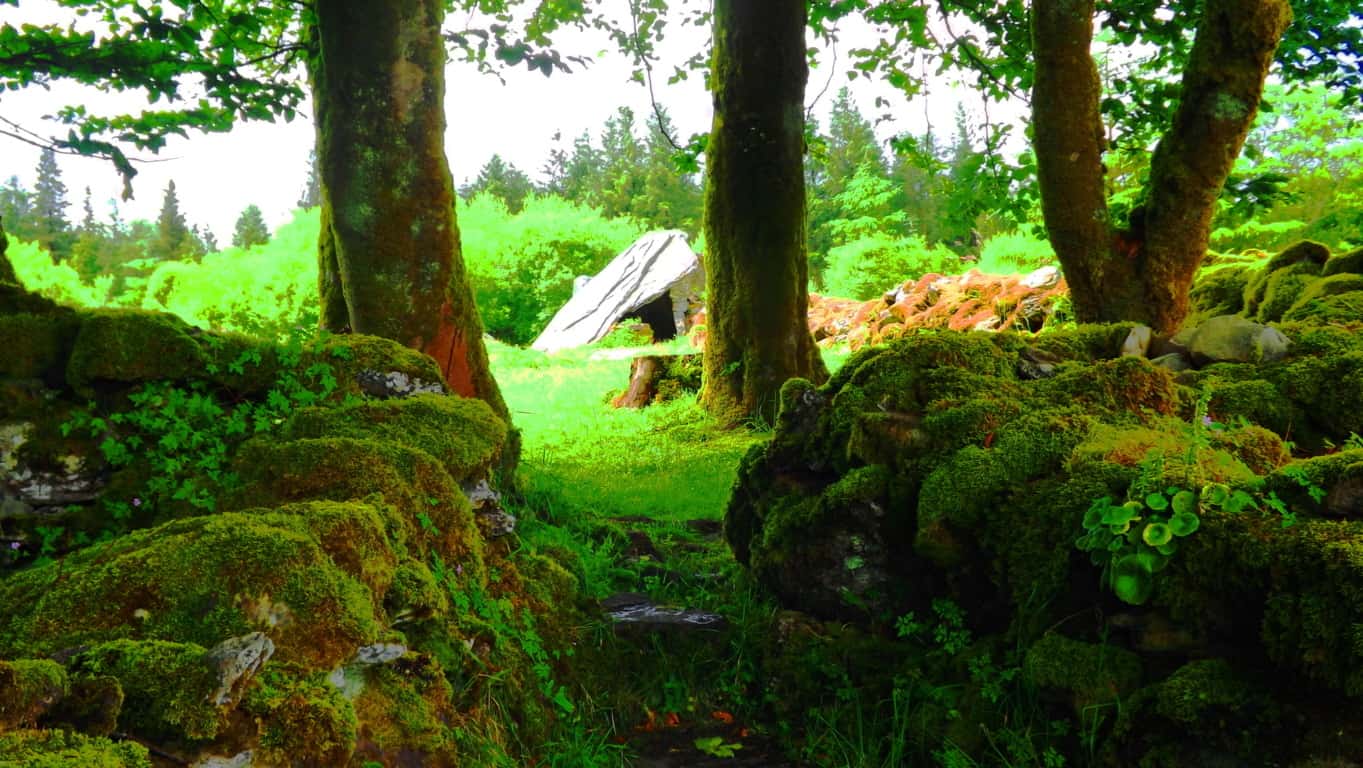 Location: Blacklion/County Cavan Ireland/Cavan Burren National Park
Location: Blacklion/County Cavan Ireland/Cavan Burren National Park
Note: Much like the way the Skellig Islands on the southwest coast of Ireland are represented in the final scene of ‘Star Wars/The Force Awakens’, Cavan Burren National Park feels like the last bastion for recluse Jedi Knights to live out their days in a galaxy, far, far away. 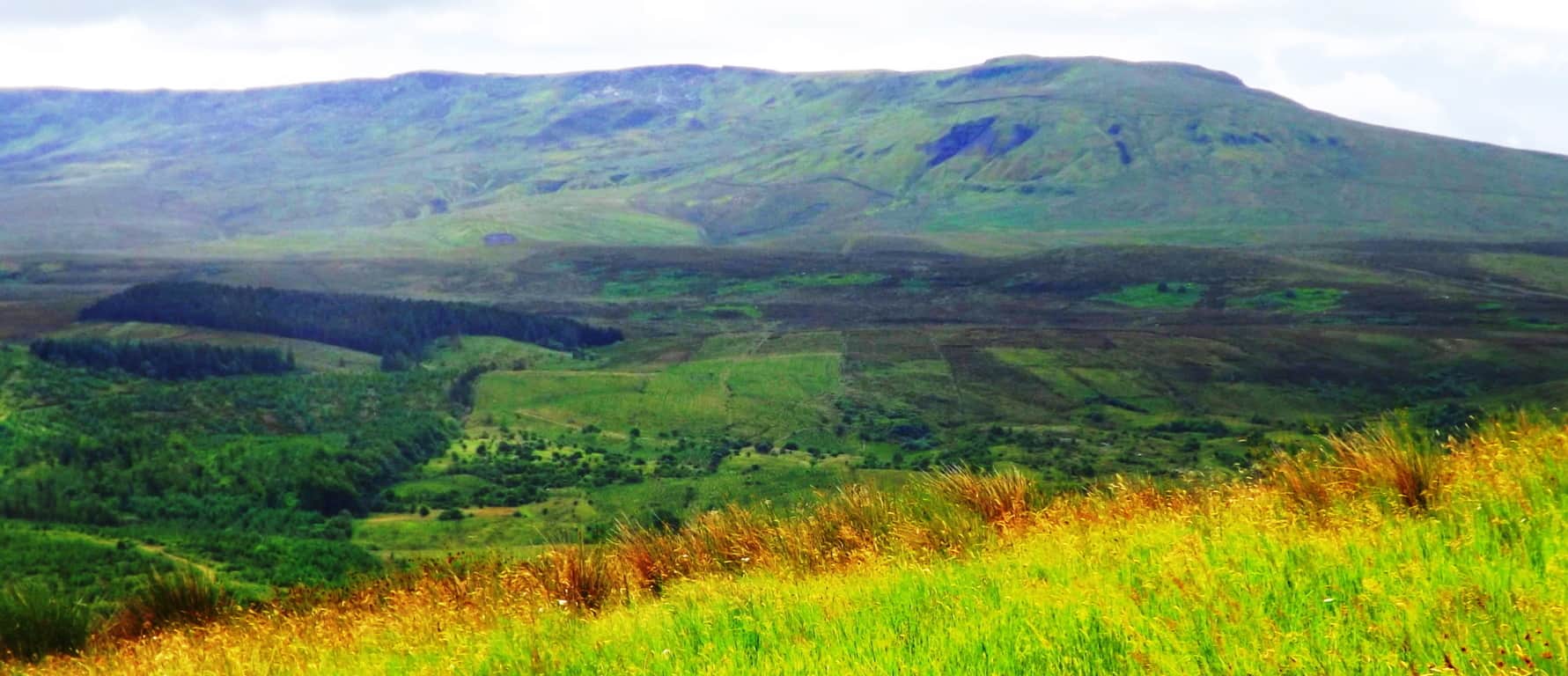 The only way to describe this set of rolling Celtic elevations, the cinematically striking Hawthorn trees vibrating on the horizon,
The only way to describe this set of rolling Celtic elevations, the cinematically striking Hawthorn trees vibrating on the horizon, the ancient stones strewn across the valley like dominos, is complete scintillation.
the ancient stones strewn across the valley like dominos, is complete scintillation.
The rare and strange megalithic ‘calf house’ in the top image above is at the base of a small mountain. The excellently constructed trails here wind down the elevation and diverge along paths which take you into pristine Celtic forest bedded entirely in clover, with ancient megaliths in mysterious rows running straight through the trees. Known as Killykeen Forest, this significant preserve of rare Celtic trees feels like an original fairytale backdrop. Adding to the universe of rolling clover are huge boulders covered in moss; these are giant green monoliths glowing between the roots and branches along the trail.
Known as Killykeen Forest, this significant preserve of rare Celtic trees feels like an original fairytale backdrop. Adding to the universe of rolling clover are huge boulders covered in moss; these are giant green monoliths glowing between the roots and branches along the trail. 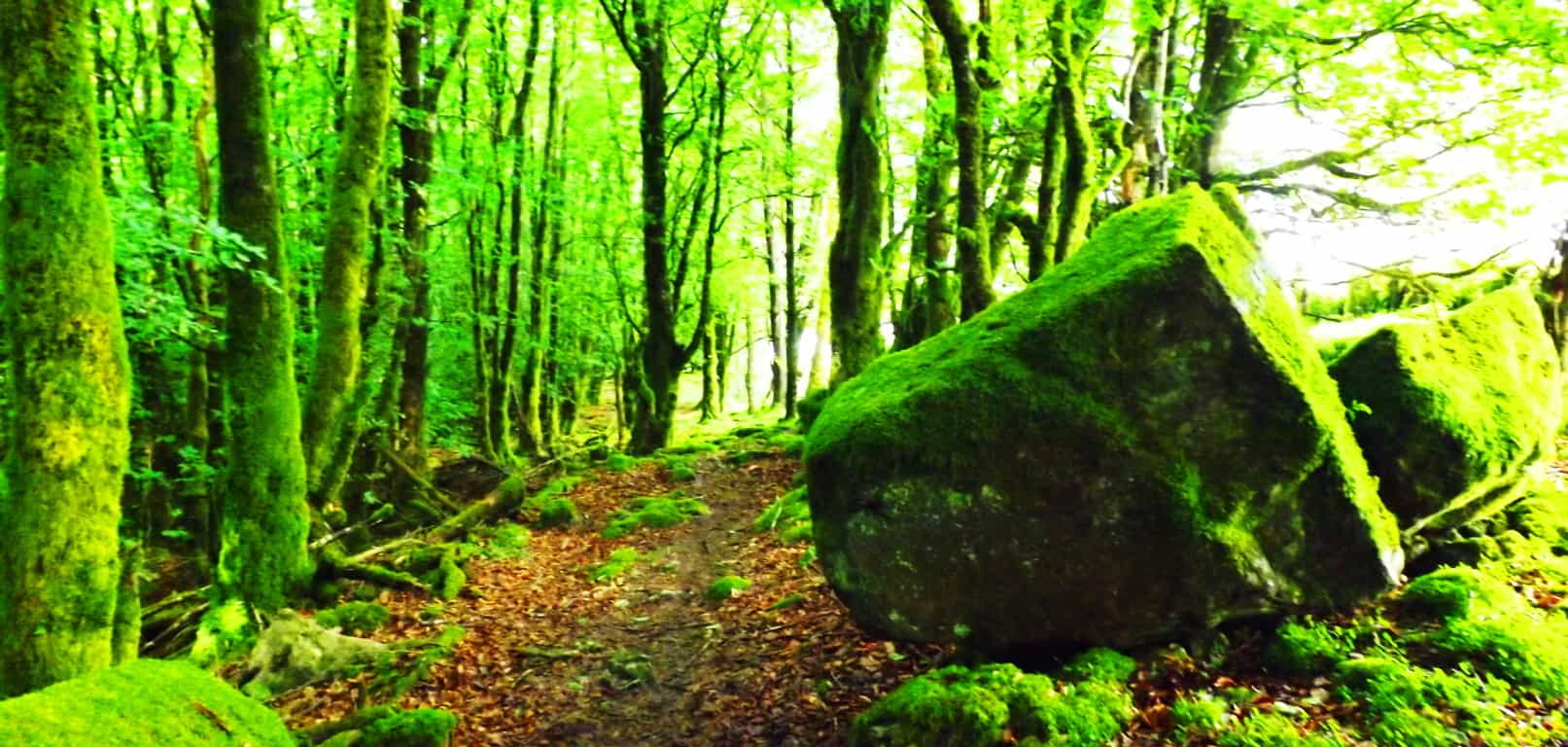
Moving deeper into the woods the sunlight blasts away beyond the hedges, while occasionally unrestricted shafts of light peak through into the inner thickets. When the Sun peaks through the mossy trees and hedges they shimmer with a misty light.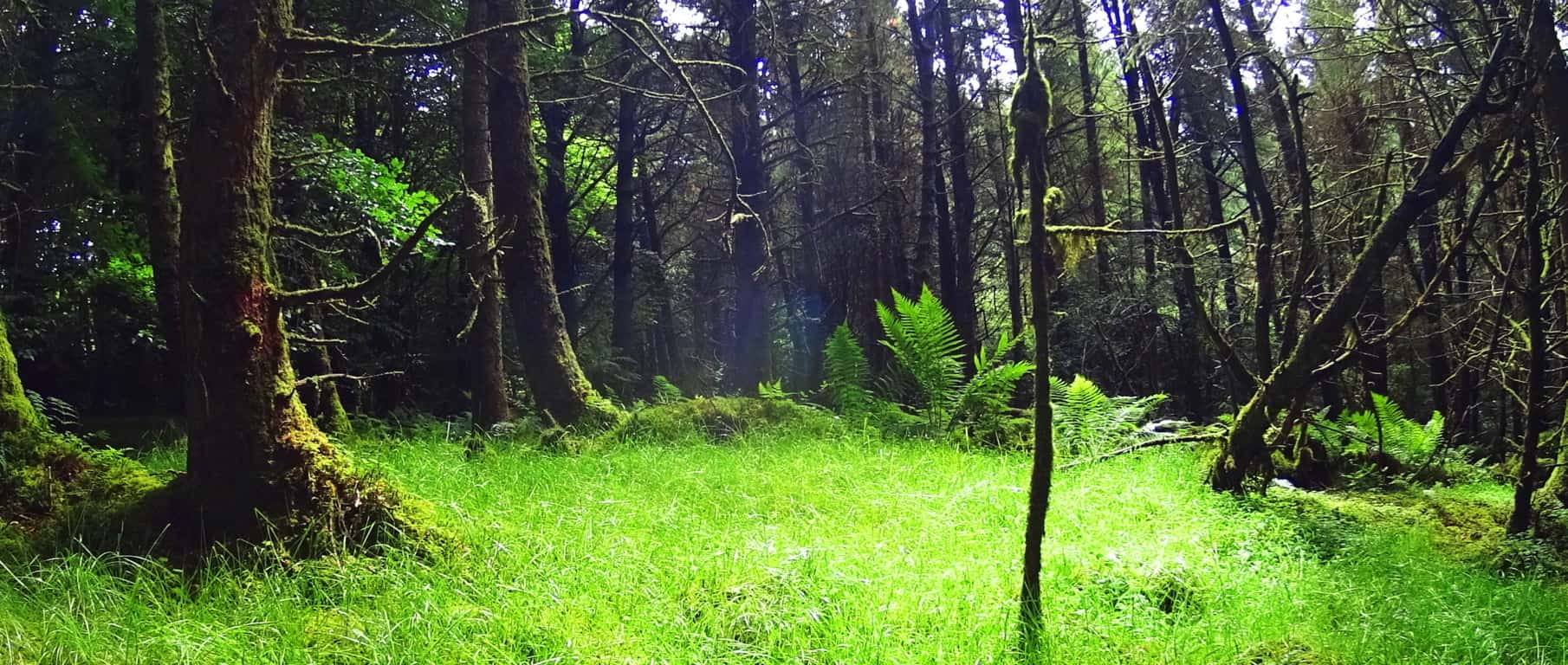 The woods here are like the opening scene for the most classic Celtic myth, at one moment bright and shimmering, and the next, shadowy and dark.
The woods here are like the opening scene for the most classic Celtic myth, at one moment bright and shimmering, and the next, shadowy and dark.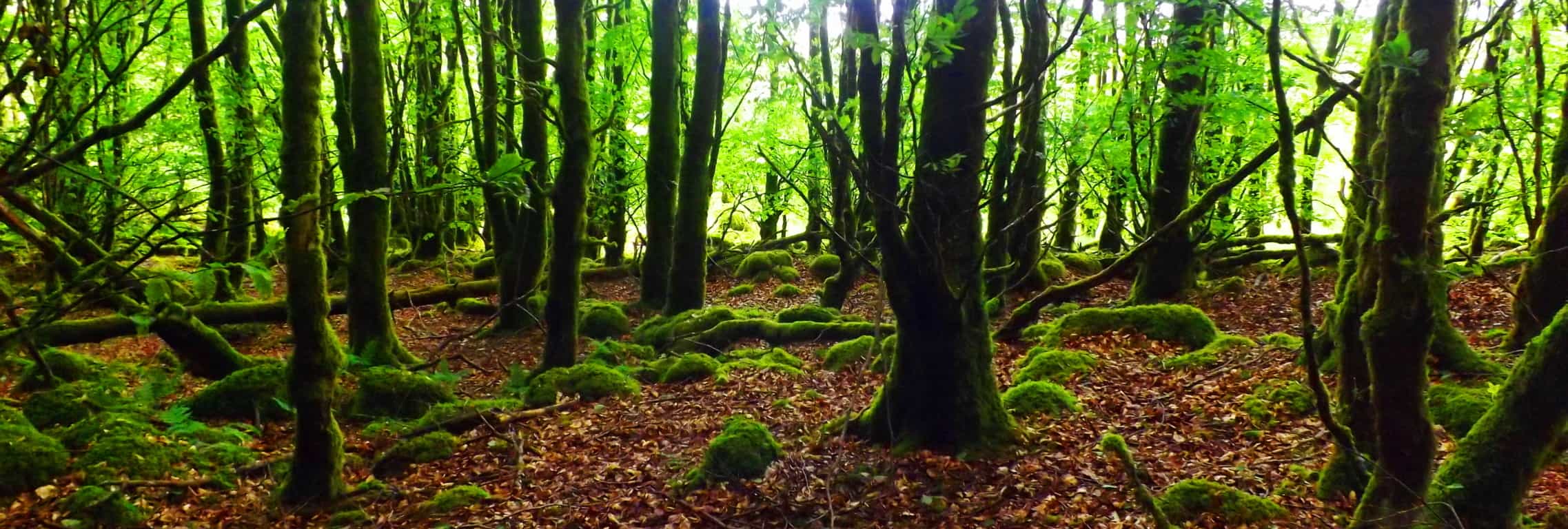 You can take the lower trail away from the forest to caverns and small cliffs where saint Patrick himself may have met with Druid kings. These caves are supported by what look like singular pillars which were carved out of the cliff at some point, either by an ancient culture, or by the wind. It is for you to decide. Before you make your decision about what’s possible and what’s not, consider some of the most amazing megalithic chambers in the world waiting to be viewed nearby…
You can take the lower trail away from the forest to caverns and small cliffs where saint Patrick himself may have met with Druid kings. These caves are supported by what look like singular pillars which were carved out of the cliff at some point, either by an ancient culture, or by the wind. It is for you to decide. Before you make your decision about what’s possible and what’s not, consider some of the most amazing megalithic chambers in the world waiting to be viewed nearby…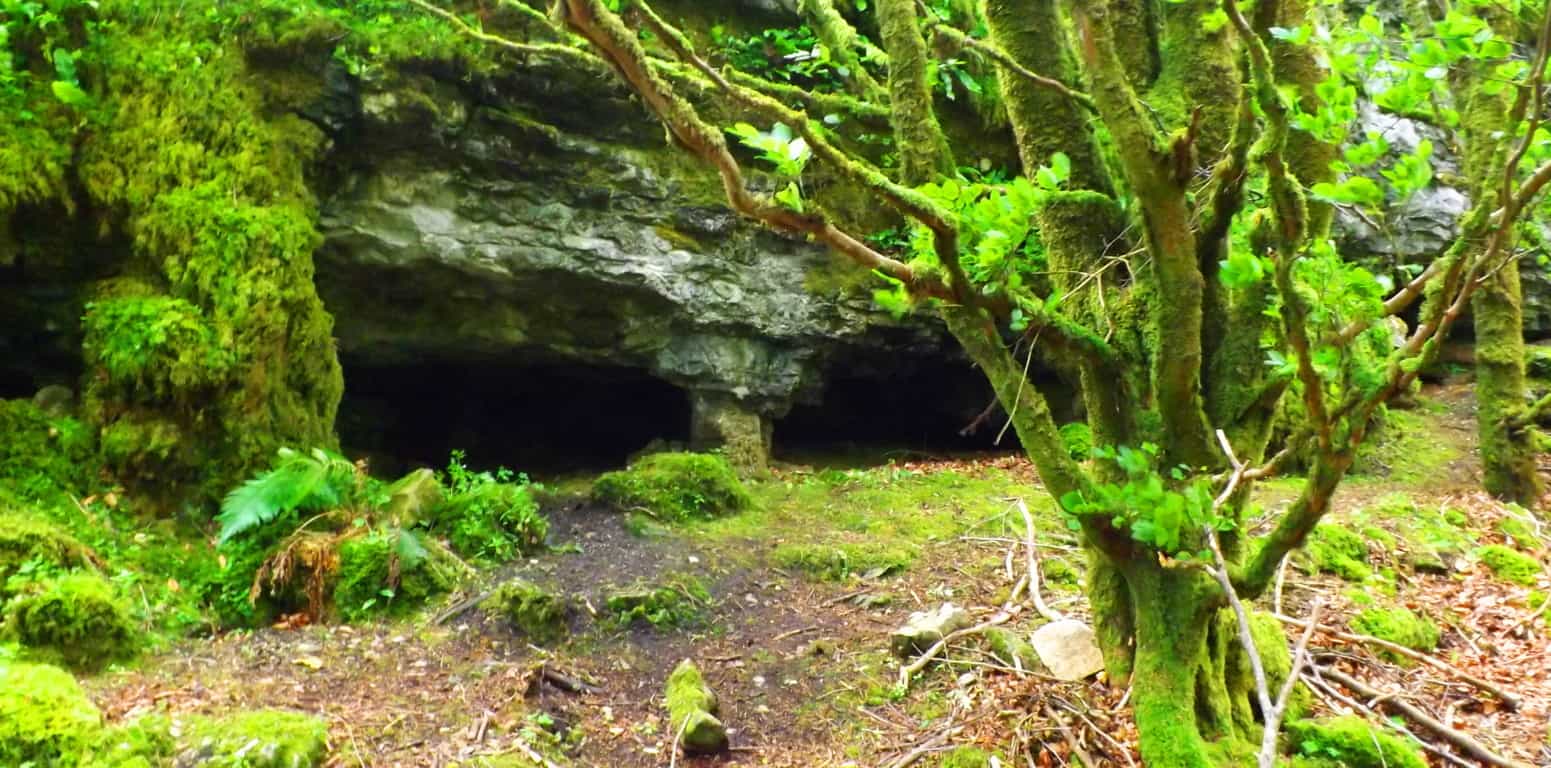 In a grove of ancient mossy stones and trees, set in an otherworldly vision about 1.5 miles into the lower trail, is one of the most amazing and mysterious megalithic chambers in Ireland. In this grove you almost expect a reclusive Jedi Knight to emerge from the mysterious stone chamber, which is clearly the centerpiece of this scene. This of course is an imaginary context, but the actual depth, beauty, and mystery that exists here is not imagined at all.
In a grove of ancient mossy stones and trees, set in an otherworldly vision about 1.5 miles into the lower trail, is one of the most amazing and mysterious megalithic chambers in Ireland. In this grove you almost expect a reclusive Jedi Knight to emerge from the mysterious stone chamber, which is clearly the centerpiece of this scene. This of course is an imaginary context, but the actual depth, beauty, and mystery that exists here is not imagined at all.
This is a 4000 to 6000 year old Celtic megalith. It is a mix of a wedge tomb, cairn, and stone chamber all in one. It should first be understood that the limestone slab that has been placed as a type of panel above the small entranceway looks to weighs at least 10 tons, if not more. This is a four inch thick, rock-strip of 7 by 14 foot wide singular slab, of solid limestone. To quarry and craft this chamber would have taken an immense amount of work, yet there are no markings on it. No chips from a chisel at its edges, or Pic-axe cuts of any kind. The dedication and resources of an entire village would’ve been necessary to quarry and move this stone to this specific spot. This seems like an extremely strange amount of effort for a Neolithic village to produce just to build a “house for a calf”, which is what the archaeologists of this area have actually had the nerve to label this chamber. The idea of a community exerting the resources and risk necessary to transfer this specific monolithic stone in a precise placement and location just to “house a cow” is insultingly absurd, and borders on fraud.
To quarry and craft this chamber would have taken an immense amount of work, yet there are no markings on it. No chips from a chisel at its edges, or Pic-axe cuts of any kind. The dedication and resources of an entire village would’ve been necessary to quarry and move this stone to this specific spot. This seems like an extremely strange amount of effort for a Neolithic village to produce just to build a “house for a calf”, which is what the archaeologists of this area have actually had the nerve to label this chamber. The idea of a community exerting the resources and risk necessary to transfer this specific monolithic stone in a precise placement and location just to “house a cow” is insultingly absurd, and borders on fraud.
A refined consideration of this chamber should first take note of the specific angle of the slab, which, as can be seen by the refractory blast of light glaring off its surface (first image above) is facing directly towards the course of the Sun through the valley. The specific angle of this extremely hard to move megalith indicates that it was intentionally placed in such a fashion in order to absorb as much of the Sun’s energy as possible. Additionally, connected to it, absorbing the Sun’s energy, are three stone-linings. This is a type of energy epicenter. Just as solar panels are angled on rooftops and plugged into an attached house for energy, this slab looks to serve the exact same purpose with the connecting stone-linings. This is a Neolithic solar panel distributing the harnessed energy of the Sun to the stone-linings which act as ‘cables’ transferring energy out to the landscape. Look at the stone-linings (which are a massive megalithic project also) in this image below, they plug-in and diverge in three different directions, which leads us to our next observation about this magical grove where wildflowers bloom like muffins in the grass.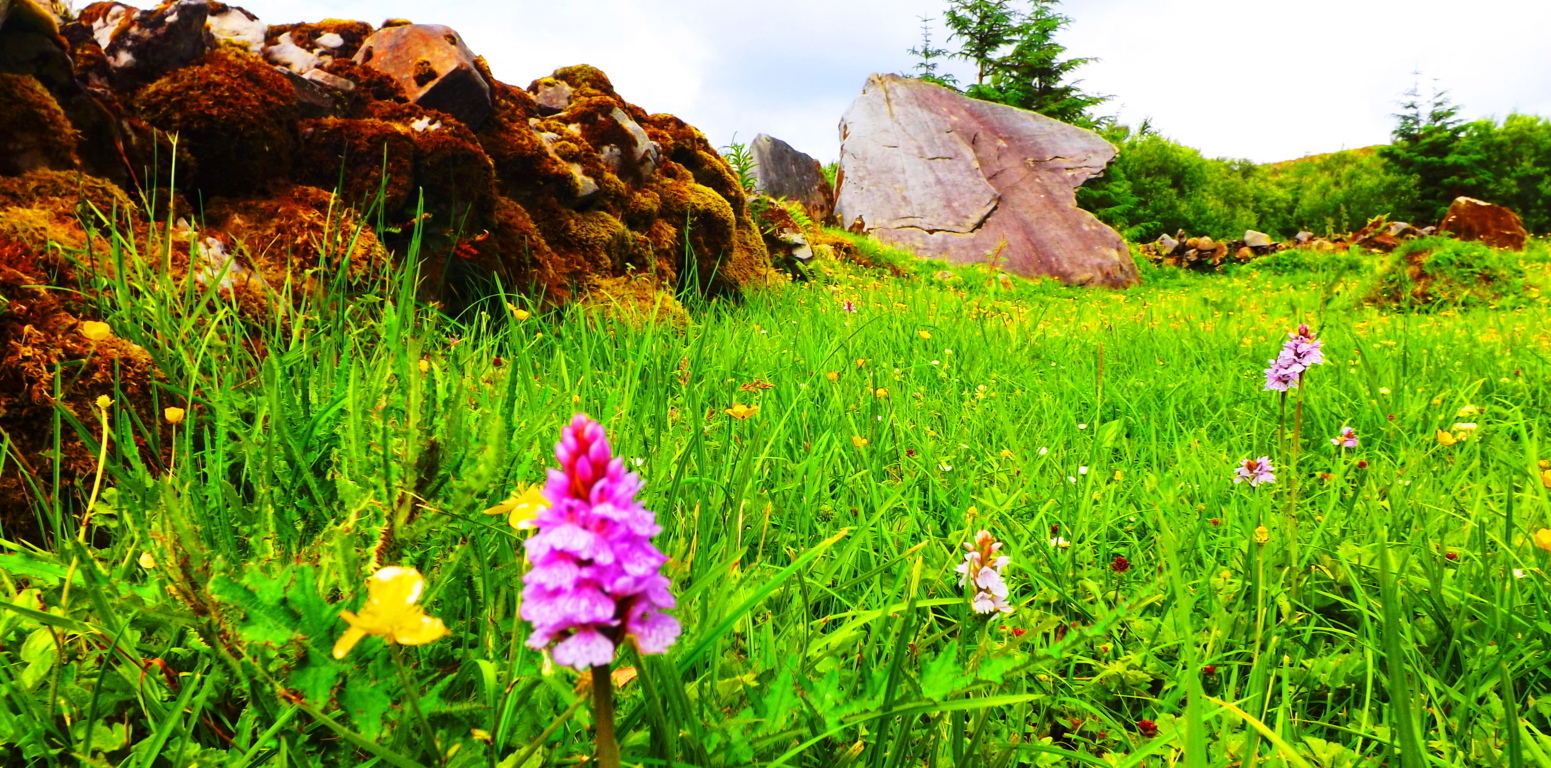 Modern archaeologists have dismissed these stones as primitive objects thrown down without any secondary functional purpose, perhaps other than to restrict the movements of herds. That’s problematic from the start. These stones couldn’t restrict a blind billy goat with three legs. This is a massive amount of effort to build something that doesn’t even perform its assumed functional purpose. This is because it’s not a “wall”. If we truly look at this scene functionally, from an engineering standpoint, it starts to make sense. Stones have energetic properties, transferring and storing energy if harnessed. How do we not acknowledge this in our particular day and age? Distributing harnessed energy is what our modern culture does with miniature ‘microchip landscapes’ every day. How could we not identify this larger model for the exact same concept, which is a landscape with connectors and harnessers of solar power that synergizes the entire area? This is the first engineering culture on earth, fully conscious of the utility properties of the elements in the landscape. Early antiquity was anything but primitive. “Archaeologists” selling people the idea that this priceless monument is a “calf house” are a patronizing disgrace.
Modern archaeologists have dismissed these stones as primitive objects thrown down without any secondary functional purpose, perhaps other than to restrict the movements of herds. That’s problematic from the start. These stones couldn’t restrict a blind billy goat with three legs. This is a massive amount of effort to build something that doesn’t even perform its assumed functional purpose. This is because it’s not a “wall”. If we truly look at this scene functionally, from an engineering standpoint, it starts to make sense. Stones have energetic properties, transferring and storing energy if harnessed. How do we not acknowledge this in our particular day and age? Distributing harnessed energy is what our modern culture does with miniature ‘microchip landscapes’ every day. How could we not identify this larger model for the exact same concept, which is a landscape with connectors and harnessers of solar power that synergizes the entire area? This is the first engineering culture on earth, fully conscious of the utility properties of the elements in the landscape. Early antiquity was anything but primitive. “Archaeologists” selling people the idea that this priceless monument is a “calf house” are a patronizing disgrace.
Just 10 yards from this beautiful chamber is an amazing isolated boulder that sits specifically above another granite foundation. There are no other level granite tables protruding out of the ground anywhere else in the grove. There are perfectly parallel slashes along the side of the free-sitting boulder, which gives the impression more akin to a sculptural statement, or display of decoration, rather than clumsy cracks from random toppling.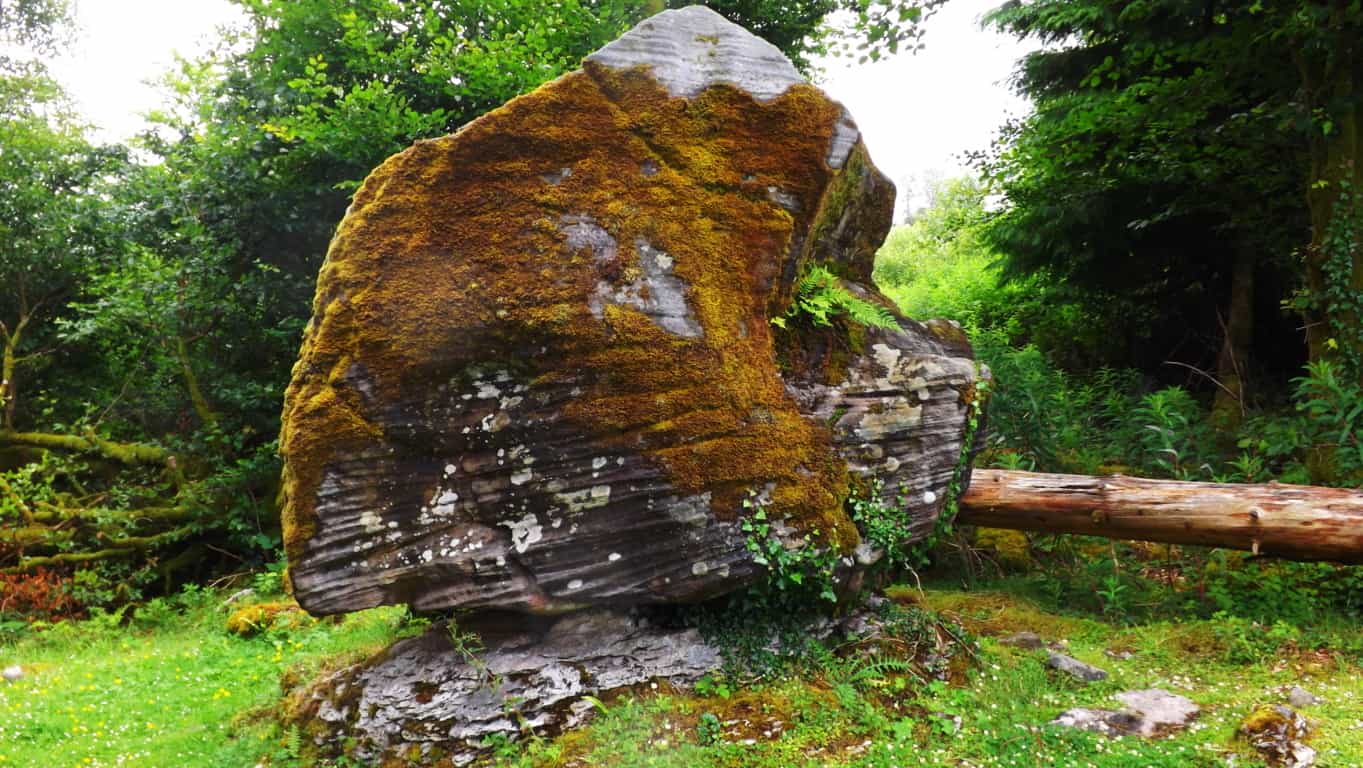 This boulder was specifically place on this exact spot as a marker for anyone approaching the area. It is obviously a statement that displays incredible strength and ingenuity, warning anyone passing through that the region is habituated by an individual(s) capable of this statement. The area is inundated with cultural megalithic statements, and yet, “scientists” somehow have the nerve to isolate this particular statement of megalithic balance and power, as random “glacial activity”. People need to get their heads around the idea of megalithic engineering in antiquity, and the ability to move and utilize massive stones. These engineered stones are in every forest and wildlife reserve from Gortnavern Ireland, to Monument Mountain Massachusetts. We need to stop being afraid of the possibility of a different history that the ‘postmodern era’ has perpetuated. Cultural history, after the last glacial flood period, spans some 12,500 years. In just the last 100 short years of human culture, which is a whopping 8% of the overall Era, ‘modern culture’ has decided to literally theorize everything, just ignoring the other 92% of cultural history along with the various forms of evidence we have inherited but mostly ignored. When defending the the 92% portion of overall history with a “modern scholar” they will dismiss the concrete evidence of engineered megaliths and historical texts with the painful logic that these statements are “just too old to be true”, or ” made-up stories created to manipulate culture”. This makes a practice of dismissing anything outside of the approved of narrative. If cultures just follow narratives and not the scenes themselves, those cultures will forget themselves. These stones are incredible coded puzzles that have been handed down to us from antiquity. They are literally priceless. In all our “modern wisdom” we still have yet to explain the purpose for these wedge tombs. This fact alone is enough to dismiss the assumptions of those who say that todays era is the height of cultural progress and achievement. It simply isn’t true, and the stones prove it. Let’s look closer.
This boulder was specifically place on this exact spot as a marker for anyone approaching the area. It is obviously a statement that displays incredible strength and ingenuity, warning anyone passing through that the region is habituated by an individual(s) capable of this statement. The area is inundated with cultural megalithic statements, and yet, “scientists” somehow have the nerve to isolate this particular statement of megalithic balance and power, as random “glacial activity”. People need to get their heads around the idea of megalithic engineering in antiquity, and the ability to move and utilize massive stones. These engineered stones are in every forest and wildlife reserve from Gortnavern Ireland, to Monument Mountain Massachusetts. We need to stop being afraid of the possibility of a different history that the ‘postmodern era’ has perpetuated. Cultural history, after the last glacial flood period, spans some 12,500 years. In just the last 100 short years of human culture, which is a whopping 8% of the overall Era, ‘modern culture’ has decided to literally theorize everything, just ignoring the other 92% of cultural history along with the various forms of evidence we have inherited but mostly ignored. When defending the the 92% portion of overall history with a “modern scholar” they will dismiss the concrete evidence of engineered megaliths and historical texts with the painful logic that these statements are “just too old to be true”, or ” made-up stories created to manipulate culture”. This makes a practice of dismissing anything outside of the approved of narrative. If cultures just follow narratives and not the scenes themselves, those cultures will forget themselves. These stones are incredible coded puzzles that have been handed down to us from antiquity. They are literally priceless. In all our “modern wisdom” we still have yet to explain the purpose for these wedge tombs. This fact alone is enough to dismiss the assumptions of those who say that todays era is the height of cultural progress and achievement. It simply isn’t true, and the stones prove it. Let’s look closer.
Just 2oo yards further up the trail is yet another priceless megalithic statement. This classic Celtic Wedge Tomb is at the top of a beautiful knoll with a 360 degree view on the Reserve. Placing these stones at this elevation would’ve been a serious endeavor, requiring years of specified labor.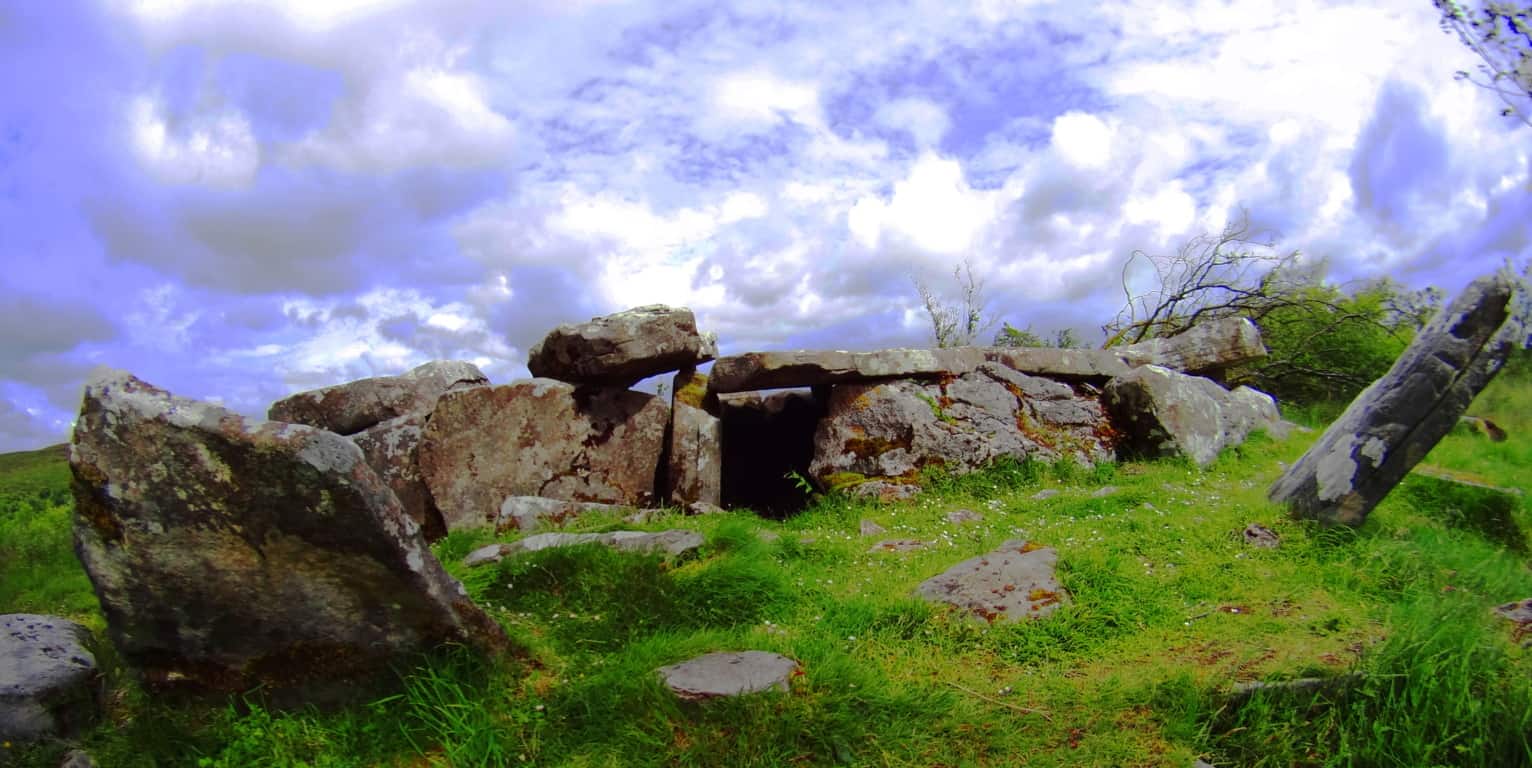
This chamber has several features that are mysterious and fantastic. Roughly measured the chamber reveals a 17 foot long set of fitted and crafted blocks of limestone. There is a captivating symmetry and set-up to these 1000 pound stones, with a centered entranceway. Two ‘pillar stones’ guard the entrance about 7 feet from the immediate left and right of the center entrance. The implementation of symmetry into a grand stone scene indicates dynamic planning and geometric comprehension, even beauty.Their are squarely placed roof and side-stones which are cut and fitted in eloquent styles. Beds of vibrant wildflowers populate the hill all around the chamber. With the clouds rolling swiftly by above the entire scene it truly feels dreamlike and utterly surreal. 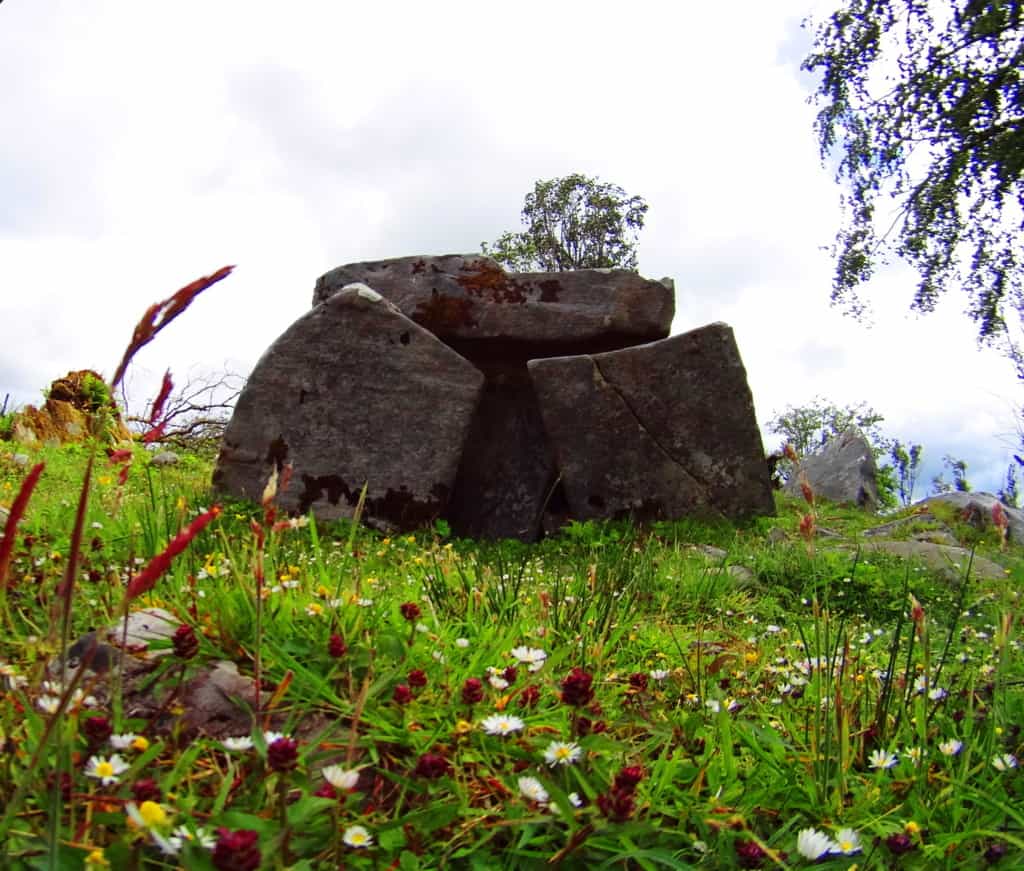 There is another classic wedge tomb on the initial elevation when starting the trail. Unfortunately this chamber is dilapidated, but with the help of the other chambers down the trail, we can make a pretty good guess as to what this scene may have looked like once. There are 1000 pound ceiling stones which have been toppled, while the side stones are no longer standing straight up. It was once a beautiful limestone chamber with an incredible view of the mountain beyond. There’s a good chance that this chamber once mimicked the beautifully distinct Culigagh Mountain in the background, which is a technique found in many of the stones at Mount Bearnagh in the Mourne Mountain Range to the east.
There is another classic wedge tomb on the initial elevation when starting the trail. Unfortunately this chamber is dilapidated, but with the help of the other chambers down the trail, we can make a pretty good guess as to what this scene may have looked like once. There are 1000 pound ceiling stones which have been toppled, while the side stones are no longer standing straight up. It was once a beautiful limestone chamber with an incredible view of the mountain beyond. There’s a good chance that this chamber once mimicked the beautifully distinct Culigagh Mountain in the background, which is a technique found in many of the stones at Mount Bearnagh in the Mourne Mountain Range to the east.
In review, the designated trails here are a short 3 mile loop that take you from megalith to megalith, branching off into the forest as well. The roads and pathways approaching the Reserve run for several miles all their own, and are completely accessible as well. This is a once in a lifetime excursion. The first culture in Ireland once thrived in this region, and found joy in creating impossible engineering spectacles built into the landscape, too grandiose to be removed some 6000 years later. Photography here is an opportunity to capture the beautiful spirit of Ireland’s oldest rural wonderland. These images tell a tale of complete beauty and mystique, of wonder and grandeur. An excursion here can lead you off-trail too, where Celtic stone-linings might be your only guide for miles. If possible, give yourself a chance to discover something away from the path. Wander into the hills to experience the breezy sway of the hillside brushing against your gear. A nearly scriptural level of simplistic beauty can emerge while passing by the flocks in these hills. The realness of witnessing a hallowed ‘rural order’ gives us a primordial reminder that life can hold incredibly simplistic beautiful moments, if we so choose. Cavan Burren National Park is the perfect place to wander into that type of moment. Seek and find.